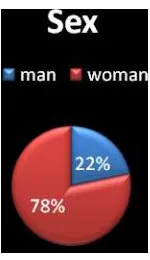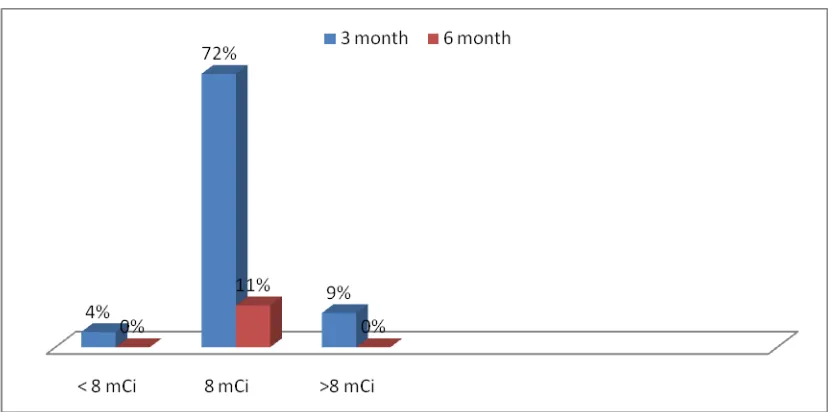FULL PAPER
Effectiveness Dose of I-131 Fixed Dose for
Hypertyroidism
(Bandung Experience)
Kharisma PK, and A.Hussein S. Kartamihardja
Department of Nuclear Medicine and Mollecular Imaging
Faculty of Medicine, Universitas Padjadjaran
Dr. Hasan Sadikin General Hospital
Bandung, Indonesia
POSTER PRESENTATION
The 13
thAnnual General Meeting of ARCCNM
Osaka, Japan
Effectiveness dose of I-131 Fixed Dose for Hypertyroidism
Background: The dose of 131I for hyperthyroidism treatment is still controversy. The dose of 131I can be given as fixed dose based on empirical experience or using calculated dose. The aim of this study was to compare the effectiveness between fixed dose and calculated dose of 131I for hyperthyroidism treatment.
Material andMethod :Retrospective study was done to 46 patients with hyperthyroidism. Fixed dose of 131I is 8 mCi, and < 8 mCi and > 8 mCi consider as calculated dose. Following up was done in 3 and 6 months.
Result :Euthyroid was observed in 3 months on 72% of patient using 8 mCi, 4% with < 8 mCi, and 9% with > 8 mCi. Euthyroidism observed in 83% using 8 mCi in 6 months and 13% using calculated dose.
Conclusion :Fixed dose of 131I more effective for hyperthyroidism treatment compare to calculated dose.
Key words : Fixed Doses, Calculated doses, Hypertyroidism, Radioiodine, I-131
Introduction :
benign and malignant thyroid conditions since the 1940s. The aim of therapy is to treat hyperthyroidism by destroying sufficient thyroid tissue to render the patient either euthyroidism or hypothyroid.3 That patients can be treated effectively merely by their having a drink of radioactive iodine on a single occasion remains a major achievement in medicine. The ideal treatment should render the patient permanently euthyroidism by a single noninvasive procedure without any serious side effects. Radioiodine fulfils most of these criteria, but against this one has to balance the delay in achieving control and the incidence of hypothyroidism necessitating life-long replacement therapy.2
Iodine-131 is a beta-emitting radionuclide with a maximum energy of 0.61 MeV,an average energy of 0.192 MeV, and a range in tissue of 0.8 mm. It remains the radionuclide of choice for therapy because of its long half-life of just over 8 days. The mechanism of action of RAI is physiological. Iodine is the precursor of thyroxine. The radioactive form of iodine is taken up by iodidetransporter of the thyroid the same way as natural iodine and is similarly processed. The b particle destroys the follicular cell, gradually leading to volume reduction and control of the thyrotoxicosis. 3
Dose of 131I for hyperthyroidism treatment is still controversy. The dose of 131I can be given fixed dose based on empirical experience or use calculated dose. However there is no agreement on the regime or the dose of RAI used and success rate is quite variable 1
Whilst several large series analyzed the number of euthyroidism patients after radioiodine treatment, There was a limited data on the time and doses taken for patients to become euthyroid2
The aim of this study was to compare the effectiveness between fixed dose and calculated dose of 131I for hyperthyroidism treatment.
Method :
and thyroid function test. Subject was considered to be euthyroidism if no clinical symptom and sign, and biochemicals finding are within normal limit.
Result :
A total of 46 subject, 10 (22%) men and 36 (78%) women met inclusion criteria were included in this study. Subject’s characteristic related to age and sex are shown on figure 1,2
Figure 1. Subject’s characteristik related to sex
Figure 2.Patients characteristic related age
Figure 3. Time to become euthyroidism and relation to number of doses of I-131
Euthyroidism was observed in 3 months on 72% of subjects treated by 8 mCi, 4% with < 8 mCi, and 9% with > 8 mCi. Euthyroidism observed in 83% using 8 mCi in 6 months and 13% using calculated dose.( Figure 3).
Discussion :
RAI is widely used for the treatment of patients with thyroid disorders, particularly in
hyperthyroidism. However, the outcomes of patients who have received RAI are differed from
study to study6. In our study, 72% patient had become euthyroidism at 3 month treated with 8
mCi. These periods are slightly faster compared to other study. Other study done by
Kendall-Taylor et al in 1984 found that after a single dose of 15 mCi, 64% of patients became
hypothyroid within the first year and 27% became euthyroidism.1
The optimal method for determining the appropriate dose of iodine-131 is remains
controversial. Techniques have varied from fixed doses to more elaborate calculations based
upon gland size (estimated either by palpation or imaging), iodine uptake, and sometimes from
Taylor et al studied 225 patients who were treated with 555 MBq (15 mCi) RAI for
hyperthyroidism to ablate the thyroid and induce early hypothyroidism. Using fixed dose
regimen, only 5.6% failed to become euthyroidism within one year of treatment6 . Leslie et al.
studied 88 patients with Graves’ hyperthyroidism who had not previously been treated with
radioactive iodine. The patients were randomized to one of four dose-calculation methods:
low-fixed, 235 MBq; high-low-fixed, 350 MBq; low-adjusted, 2.96 MBq (80-Ci)/g thyroid adjusted for 24
hours RAI uptake; and high-adjusted, 4.44 MBq(120-Ci)/g thyroid adjusted for 24-hour RAI
uptake. Subjects were followed for a mean of 63 months to assess clinical outcomes. Mean
treatment doses weresimilar in the different outcome groups. Leslie et al.could not demonstrate
any advantage to using adjusted dose method. Survival analysis did not demonstrate any
difference in the time to outcome between fixed and adjusted dose methods.7 A. de Rooij in
meta-regression showed no effect of follow-up duration on the difference in euthyroidism
between estimated and calculated activity9 .
In this study there was not observe a significant association between cure rate and sex. This
result is consistent with the outcome of many other studies that did not show gender to be a
significant prognostic factor in patients’ responses to RAI treatment. But, in contrast,
Allahabadia et all .found that males had a significantly lower cure rate than females after one
dose of RAI.8 We also did not observe association between age, etiology and the use of
anti-thyroid medication prior to RAI and the outcome following RAI. Y Khalid et.all found that there
was no statistically significant correlation between age, gender, aetiology and the use of
anti-thyroid medication prior to RAI and the outcome following RAI therapy although a high free
thyroxine level at diagnosis predicted a failure of the first dose to achieve a cure of
between these factors and the response to RAI therapy.1 In our study, a good result was seen in
euthyroidism was observed in 3 months on 72% of patient using 8 mCi, and euthyroid observed
in 83% using 8 mCi in 6 months after treatment.
Conclusion :
Fixed dose of 8 mCi 131I is more effective for hyperthyroidism treatment compare to calculated dose.
Refferences :
1. Y Khalid et.all, Efficacy of fixed high dose radioiodine therapy for hypertyroidism- a14 years experience : A focus on influence of pre-treatment factors on outcomes, BJMP 2011.
2. P J Hoskinet.all ,Low-dose radioiodine given six-monthly in Graves’disease, JRSM 1985.
3. Malik Mumtazet.all, Radioiodine I-131 for the therapy of Graves’ disease,MJMS 2009. 4. Douglas Howard et.all, Determination of the optimal minimum radioiodine dose in
patient with Graves’disease : a clinical outcome study, EJNM 2001.
5. Rebecca S.Bahnet.all,Hyperthyroidsm and oher causes of tyrotoxicosis, ATA 2011. 6. Ajit.S.Shinto, Fixed Dose Radioactive Iodine Therapy in Hyperthyroidism:
Outcome and Factors Affecting it in a Region in South India, Thyroid Science 5(6):1-7, 2010.
7. Leslie W, Ward L et all, A Randomized Comparison of Radioiodine Doses in Graves’s
Hypertyroidism.,J.ClinEndocrinolMetab, 2003
8. Allahabadia, A., Daykin, J., Sheppard, M.C., et al.: Radioiodine treatment of
hyperthyroidism-prognostic factors for outcome. J. Clin. Endocrinol.Metab., 86(8):3611–
9. A. de Rooij ,Clinical outcomes after estimated versus calculated activity of radioiodine
for thetreatment of hyperthyroidism: systematic review and meta-analysis, European
Society of Endocrinology, 2009.

